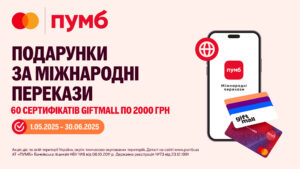
Mastercard, together with PUMB, is launching an exciting promotion for everyone making international transfers. It’s simple: send or receive money to a Mastercard card via the PUMB app and automatically enter the draw for valuable prizes!
The “Gifts for International Transfers with Mastercard” promotion runs for two months: from April to May 2025.
PUMB clients who own a Mastercard and make or receive international transfers through the bank’s mobile app.
Sending via the PUMB app with a Mastercard:
Receiving via the PUMB app to a Mastercard:
Every month, 30 electronic gift certificates from giftmall worth 2,000 UAH each will be raffled.
– The more transfers you make, the higher your chances of winning!
A total of 60 winners will receive a notification on their mobile phone with details on how to use their certificate.
Send and receive international transfers to Mastercard cards via PUMB, enjoy convenient services, and get rewarding bonuses!
Details and official rules here.

On December 15, the Kyiv Event Hall by Ramada Encore hosted an outstanding event – the annual SBC Ukraine Awards ceremony. Among the partners of the event, a special place was taken by HITBIT PRO, which presented its innovative cryptocard and confirmed its status as a technological leader in Ukraine.
HITBIT PRO is a Ukrainian startup created by Igor Kucherenko and Dmitry Nikiforov that is changing the way people think about the convenience of financial transactions. Their main product – a cryptocard – allows you to pay for purchases in cryptocurrency, exchange and withdraw funds directly through POS terminals in any country in the world.
At the event, the HITBIT PRO team presented an interactive stand where guests had the opportunity to see the product in action. Visitors were able to register, order a card, and try out real-time payment. This demonstration caused a real sensation among the participants of the SBC Ukraine Awards.
“Our mission is to make financial transactions simple, convenient and accessible to everyone. We are proud that our product represents Ukraine in the global financial arena,” said Igor Kucherenko, co-founder of HITBIT PRO.
HITBIT PRO has received positive feedback not only from business representatives, but also from marketing agencies that already see the prospects of cooperation with such an innovative product. Thanks to such initiatives, SBC Ukraine Awards is becoming a platform for discovering new ideas and solutions in the field of sports, business, and technology.
CRYPTO CARD, DMITRY NIKIFOROV, HitBit Pro, MASTERCARD, Ігор Кучеренко
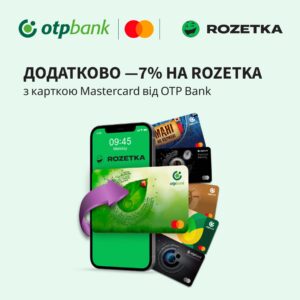
A new promotion for the winter holidays for Mastercard cardholders from JSC OTP BANK. Buy gifts for your family and friends, goodies for the New Year’s table and many other goods in the Rozetka online store or mobile application with a 7% discount when paying with a Mastercard from OTP BANK.
In order to take advantage of the offer and purchase goods at a discount, you need to pay for your purchases on the website rozetka.com.ua or in the Rozetka application with any Mastercard from OTP Bank.
Buy goods from the Rozetka seller with a special mark and choose the payment method “-7% discount when paying with a Mastercard from OTP Bank”. The discount will be credited automatically upon payment.
The promotion is valid from December 6 to 22, 2024.
For more details, please follow the link: https://www.otpbank.com.ua/action/rozetka-per7/
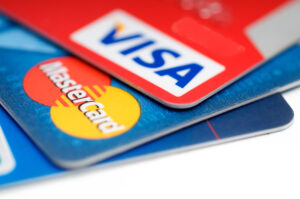
The Antimonopoly Committee of Ukraine has granted permission to MasterCard Europe S.A. and Visa International Service Association to reduce the amount of domestic interchange fees (interchange rate) paid by an acquirer to an issuer in Ukraine from 0.9% to 0.7% for the period of war.
“The planned changes in concerted actions are aimed at establishing an effective and balanced ceiling on interchange rates, taking into account the interests of all market participants under martial law,” the AMC commented on its decision of 5 October.
The Committee expects that these changes will allow retail chains to maintain the current price level for consumers, as well as contribute to the development of small and medium-sized entrepreneurs and the overall economic development of Ukraine.
The agency clarified that the 0.7% rate will be effective “not earlier than the next business day after 14 calendar days after the date of receipt of the Committee’s authorization until the next business day after 30 calendar days from the date of termination or cancellation of martial law.”
It is noted that after this period, MasterCard and Visa will return to the 0.9% rate agreed with the AMCU before the war.
“The introduction of a further reduction in the interbank commission is an attempt by government agencies and other industry representatives to respond to a request for assistance to retailers who have suffered significant economic losses caused by the war,” the AMCU said.
As reported, a memorandum signed in May 2021 between MasterCard, Visa and the NBU provided for the interchange rate to be set at 1.2% from July 1, 2021, and its gradual reduction, in particular from July 1, 2023, from 1% to 0.9%.
However, during the war, the rate was first reset to zero and then gradually increased to 0.7%. The decision of Visa and MasterCard to return it to 0.9% on July 1 this year was sharply criticized by retailers. The largest banks in the market – PrivatBank, Oschadbank and Raiffeisen Bank – for their part, kept acquiring rates for their clients unchanged (approximately 1.3-1.5%), but called on MasterCard and Visa to support this initiative and cancel the interchange rate increase from July 1, 2023 to 0.9%.
However, Oschadbank noted that “if payment systems do not reduce the interchange rate within one to two months, the bank will reconsider its decision.”
According to the NBU, the share of payment terminals of PrivatBank, Oschadbank and Raiffeisen Bank at the beginning of the year was 60.4%, 19.6% and 7.6%, respectively.
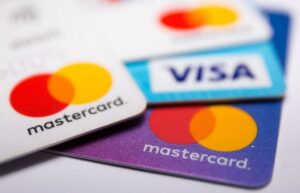
Payment system operators Visa Inc. and Mastercard Inc. plan to increase the fees charged to retailers when their customers pay for purchases with bank cards, Bloomberg reports, citing documents in its possession.
Visa’s fee hike for online transactions will start in October and will affect credit, debit and prepaid cards in April. In the case of Mastercard, the increase will also start in October.
Industry consulting firm CMSPI estimates that the annual amount of fees paid by retailers could increase by more than $500 million as a result.
Although the fees are set by Visa and Mastercard, the bulk of the fees are collected by the banks that issue the cards. While the fees are small, retailers’ costs to pay them have risen in recent years as more shoppers use credit cards, which carry higher fees than debit cards.
Retailers shift at least some of these costs to consumers by raising prices. Small businesses often offer discounts to customers who pay with debit cards or cash.
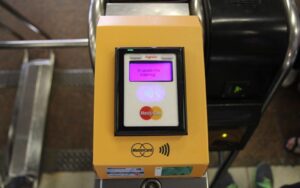
The State PrivatBank (Kyiv) and the MasterCard international payment system have launched contactless fare payment at all metro stations in Dnipro, the bank’s press service reported on Thursday.
“In August 2022, as part of the program with MasterCard, the bank installed turnstiles with contactless payment technology with a bank card at four more stations of the Dniprovsky metro – Metrostroiteley, Prospekt Svobody, Metallurgov and Zavodskaya. Now you can pay for travel with a card or smartphone at all metro stations,” the statement said.
For two years of operation of such turnstiles at the stations “Vokzalnaya” and “Pokrovskaya” in the Dnieper, more than 420 thousand trips were paid contactlessly.
The press service noted that the Dnipro metro has become the second metro in Ukraine after the Kyiv one, where you can pay for travel with a card or an NFC device right at the turnstile.